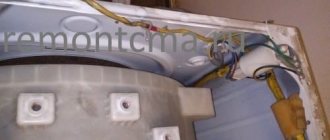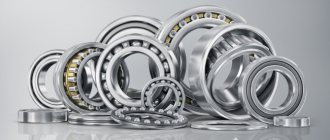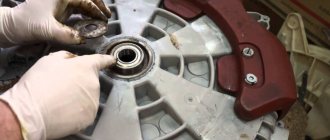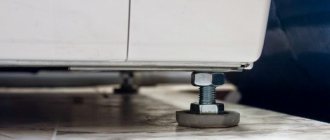What is a belt?
This is one of the important components of a washing machine because it transmits torque to the drum. Without it, the washing process will be impossible.
The belt lasts for many years if it is made of high-quality material and all requirements for operating the machine are met. A large number of belt drive failures occur due to the drum being overloaded with things. In this situation, the belt flies off the pulley or breaks.
The element is a connecting element from the electric motor to the drum. After power is supplied, the motor picks up speed and spins the drum through a belt.
But what often happens is that the belt in the washing machine comes off. Let's try to figure it out together about why this happens and what should be done.
How to replace a belt in a washing machine
To replace the belt, you must first turn off the power to the machine and make sure that there is still water in it. Don't rush to go to the store for a new belt. First you need to dismantle the old one to find a suitable replacement. Because manufacturers use belts of different lengths and widths. The replacement procedure includes the following steps:
- You need to move the machine. This procedure is necessary if the machine is facing the wall with its back panel. If necessary, unscrew the inlet hose;
- Remove the back panel. For this you need a regular sacral screwdriver. The back panel is usually secured with 4-6 bolts. If the wall does not give in, you need to visually inspect the machine; there may be additional fastening bolts on the side panel or bolts with a recessed head;
- After removing the back panel, you need to remove the belt. You need to rotate the pulley by pulling the belt towards you.
After dismantling, you can install a new belt. Make sure it is identical in size and fits exactly. To do this, after installation, rotate the pulley. The belt should fit snugly and the drum should turn without effort.
If you have any doubts about replacing the belt in your washing machine yourself, contact our specialists.
The video will help you understand in detail the procedure for replacing the belt:
Main reasons
Most often the problem occurs in the following cases:
- Natural wear of the element has occurred. This happens due to prolonged use of the device. The belt is stretched and does not transmit rotation correctly. This is accompanied by a characteristic whistle at idle, poor spin performance, and machine stops if the belt finally breaks or falls off.
- The drum pulley is loosely secured. Assemblies and assemblies that are in motion are subject to heavy loads, and their fastenings weaken. When the pulley begins to “walk” in different directions, the strap will definitely break off, break completely, or simply get jammed.
- Loose motor mounts. Due to vibration during washing, they may lose strength. The tension will become insufficient, and this will be another reason why the belt comes off. In order to finally verify what happened, you will have to unscrew the back panel of the machine, check the belt and the elements located near it. If necessary, the fastenings are tightened, the belt is installed and tightened, and the machine is checked for functionality.
- The shaft and pulley are deformed. A belt coming off causes the pulley to bend, which will require its replacement. Otherwise, there is a possibility of damage to equally important components of the washing machine. The same situation can happen with the shaft. In a word, a malfunction of one of the nodes will lead to problems.
- The bearing is worn out. This can warp the drum, and the result will be a flying belt. To determine the exact cause, you will have to invite an experienced technician.
- Incorrect belt tension. Replacing the belt is not difficult, but certain skills are required so that it does not fall off in the future. In this case, it is necessary to perform the tension correctly, otherwise the problem will periodically recur.
- Damage to the drum cross. In this case, there is an imbalance, which will result in the drive element falling off.
- Rare cases of use. It may seem strange, but this can be one of the reasons when a rubber product dries out, cracks and falls off or breaks completely.
As you can see, there are plenty of conditions for the belt to break or fall off. Without special skills, it will be difficult to find the problem. If you want to resolve the issue radically, invite a specialist who will quickly and competently resolve everything.
Possible causes of malfunction
- Belt wear. The most common reason why it can fly off. If the belt is stretched, then during operation it flies off the drum or simply slips, making whistling sounds. Sometimes the belt breaks at the point of wear.
- There is a problem with the pulley fastening. The pulley can come loose, causing the belt to fly off. Check the fastening for tightness and tighten if necessary.
- The engine mount is loose. The engine can become loose over time, causing the belt tension to decrease. Check how well the engine is secured.
- Deformation of the pulley or shaft. When a belt comes off, it can damage the pulley or the shaft itself. In this case, replacing the belt will not work; you will have to replace all the damaged parts. It happens that a pulley or shaft is initially irregular in shape due to a manufacturing defect. If such a malfunction is discovered during the first operation, it is better to immediately return the machine under warranty and demand a replacement.
- Damage to the crosspiece. The crosspiece connects the shaft to the tank; it can weaken or completely burst, which will create an imbalance and lead to the belt breaking. The bolts should be tightened or the crosspiece should be completely replaced.
- Incorrect installation of belt or pulley. If you have already tried to repair these parts, you may have made a mistake during assembly. Contact a specialist for help.
- The pulley or belt does not fit your machine. When doing your own repairs, you may have purchased the wrong part.
- Bearings are worn out. This causes the drum to rotate unevenly, which can cause the belt to fly off. This malfunction may be indicated by the machine knocking in the spin mode.
To change the washing machine belt yourself, you must follow these steps:
- Turn off the water and unplug the washing machine from the outlet.
- Unscrew the fastening screws on the back wall of the machine and remove it.
- Remove the old belt: to do this, you need to pull it towards yourself while simultaneously rotating the pulley by hand.
- Place the new belt on the motor shaft.
- Carefully pull the belt onto the pulley, also rotating it by hand.
- Check that the belt is level and adjust it if necessary.
- Replace the back cover.
- Run a test wash to make sure the machine is working properly.
Pay attention to whether the belt has damaged wires, sensors and other elements located nearby. It is advisable to diagnose and eliminate these faults along with replacing the belt.
How can the user understand that there is a problem with the drive belt? Certain signs indicate faulty parts: error codes, extraneous sounds.
Find out how you can diagnose a breakdown yourself, what signs you need to look out for, and how to replace the drive belt in your washing machine.
How to determine that there is a problem with the drive element in the SMA:
- The self-diagnosis system of the washing machine showed an error code on the display.
- When washing, the drum does not rotate, but it can be turned by hand.
- During operation, the drum rotates very slowly, and extraneous scraping sounds are heard.
Why is such a breakdown dangerous? Because if it breaks, the belt could catch and break the wiring or damage the sensors.
You can accurately determine the cause of the problem by removing the wall of the washer and inspecting all the parts.
Why does the belt come off? Here are the most common causes of the problem:
- Problems with the drum pulley. Improper loading of laundry, overload and imbalance can lead to malfunction and breakage of the pulley. As a result, the belt jumps off and falls off, which leads to a stop in the operation of the SM.
- Wear. Each belt has its own service life. But few products work before the end of this period. The probable cause of wear is the design of the washing machines. Narrow machines have parts that are tightly packed together, which leads to rapid wear.
- Incorrectly folded laundry. If the drum is overloaded, an imbalance occurs - all the laundry is shifted to one side. When spinning at high speeds, the drum may suddenly hit the tank, causing the drive element to jump off.
- Problems with bearings, which are needed for uniform rotation of the drum. If the bearings are not replaced in time, this leads to severe vibration of the pulley. Consequently, the belt can not only fly off, but also break.
- Too infrequent use of the SMA causes the belt to break. How does this happen? With infrequent use, areas of the drive element shrink. The next time they are started, they fray, which leads to stretching and breakage.
How is a breakdown detected?
It is difficult for the user to understand what happened to his home assistant - when the drive belt falls off, the unit stops working. The element is located behind the body panels of the unit for washing clothes, and there is no way to immediately understand that the problem is hidden in it. But this can be done if you understand the characteristic features.
Often, the washing machine signals an incident using a built-in self-diagnosis system. With the help of such a system, the machine easily reacts to a failure, stops working, and sends an error code to the screen, depending on the model and brand of the product. All you have to do is use a special table to decipher the signal data seen on the screen.
It happens that the machine does not produce a code, but there is already a breakdown. In such a situation, it is possible to understand that the belt has fallen off and needs to be returned to its place, perhaps with the help of indirect signs:
- The washing program is activated, the motor is operational, but the drum does not rotate;
- the motor hums evenly and begins to “go silent” with equal time pauses;
- the software works, the engine hums without stopping, then the electronics freeze;
- The drum can be easily rotated by hand; rotation does not create even minimal noise.
Diagnosis of the problem
How to understand that the problem is in the belt? If the washing machine drum does not spin, but it rotates too easily by hand, or if it spins weakly and makes a scraping sound, there is most likely something wrong with the belt. The reason may be different, but checking the belt is the simplest procedure that you can perform yourself without turning to a specialist. When the belt comes off the first time, you can try to put it back on. Depending on the reason why this happened, the machine may or may not continue to operate normally. But if the belt flies off again or breaks altogether, a replacement is definitely needed.
Installation procedure
The process is easy, even an inexperienced user can handle it:
- First of all, the machine is disconnected from the power supply.
- To conduct an inspection and determine the malfunction, you will have to remove the back cover of the washing machine by unscrewing the mounting bolts.
- When the drive belt comes off, you should simply install it in its intended place. To begin with, the element is put on the shaft, then it is pulled onto the pulley. Initially - to a certain part of the circle, then the pulley is carefully rotated so that the belt falls into place completely and is completely placed in the groove. To make sure everything is done correctly, the pulley is turned by hand.
- When a belt stretches or breaks, a new analogue is purchased. This can be done at a service center or a dealership that specializes in washing machines and their accessories.
- All that remains is to close the machine panel and screw in the bolts.
Causes of belt failures
Belt wear
In narrow devices, all elements are located very close to each other and to the body. Therefore, at the moment of wear, such parts are free and rub against each other, causing severe wear.
Cracked drum pulley
There are several reasons: the pulley is cracked, the automatic machine was overloaded, the element is not tensioned correctly. A broken pulley cannot hold the belt, so it must be replaced.
The cause of the failure is wear of the bearings
Severe wear can lead to high vibrations of the spin unit and the device drive. When they reach their peak, the strap stretches, slips, or breaks. After which repairs are required.
Incorrect loading and operation of the washing machine
The belt can fly off if the drum is not loaded correctly and excessive vibration is caused.
This element can dry out and become very thin if the equipment sits idle for a long time. Very often, in side-loading machines, plastic parts exhibit fatigue deformation, which leads to a violation of the arrangement of the elements. After which the strap may fly off along with the pulley shifting. In such situations, it is better to buy a new device than to adjust the equipment.
Is there any point in doing your own repairs?
If you have not done such repairs with household appliances before, it is recommended to invite a specialist who will fix the problem and provide a guarantee for the further operation of the machine.
Any user can preliminarily inspect the washing machine and try to diagnose a breakdown. Having discovered a problem, you will have to decide whether to seek help or try to cope with the problem on your own.
Contacting a workshop has its own advantages:
- a warranty period is determined for the work;
- replacement of components, if such a need arises, will be carried out with identical analogues;
- The experience of the masters will be beyond any doubt.
Why does the belt come off on a washing machine?
Usually, if everything is in order, the belt works as it should and does not require intervention. But if it flew off for you the first time
, then you shouldn’t worry too much, because this is still an isolated case and can be caused by an imbalance caused during washing or spinning a large amount of laundry. You will just need to put the belt back in place and continue using the washing machine.
In order to put on the belt, you will need to remove the back wall of the washer. Below you can read how to change the belt in a washing machine; you will need to do the same work, only with the old belt.
If the belt keeps falling off
and this is systematic, then here it is already necessary to understand the reasons, which may be the following:
- The belt has worn out
- the first and most obvious reason for the constant slipping of the belt is wear and tear. Most likely the belt has stretched and during operation it simply slides off the pulley. If the belt is stretched, it can also slip during operation, producing a characteristic “whistle”. It may happen that the belt is completely torn or damaged. In any case, you need to remove the back wall of the machine and inspect the belt itself. - The fastening of the pulley is broken
- a situation occurs when the pulley could unwind, causing the belt to fly off it. Check its fastening and tighten if necessary. - The engine is loose
- the engine mount is loose and because of this the belt is not tensioned enough and falls off. Check that the motor is securely secured. - The pulley or shaft is deformed
- the problem may be due to the fact that the pulley is bent and has an irregular shape, the same can happen to the shaft itself. This can happen if the belt came off for the first time and bent the pulley. If the washing machine is new, then there may be a manufacturing defect, in which case it is better to immediately return the machine under warranty. If the pulley or shaft is deformed or damaged, they need to be replaced. - The crosspiece is damaged or weakened
- the shaft is attached to the tank using a crosspiece, which could burst or weaken, causing an imbalance. In this case, it needs to be replaced or the mounting bolts tightened. - The pulley or belt is installed incorrectly
- if you have recently repaired these parts, then most likely you made an error in the assembly and installed them incorrectly. You should call a washing machine repairman to solve this problem. - The “wrong” belt or pulley is installed
- if you recently changed the pulley or belt, you may not have bought it from your washing machine, and it didn’t fit. - Wear of bearings
- if the bearings in your washing machine are worn out, then the drum rotates skewed and the belt can fly off. This malfunction is also accompanied by a knocking sound from the washing machine during the spin cycle.
If you are unsure of identifying the correct cause, then it is best to seek professional help.
Preventive measures - a way to extend the operating period
Fulfilling certain requirements while using the machine will have a beneficial effect on the operation of various components, prolonging the operation of the entire device. Each machine comes with an accompanying instruction manual, which describes the rules of use and recommendations for preventive measures. Many simply do not pay attention to this, removing the documents and forgetting about their existence. And if you follow all the tips and handle the equipment carefully, the machine will thank you with uninterrupted operation.
What can cause belt problems?
A belt, like any other product, has its own expiration date. Over time, it may stretch or even burst. Sometimes, during intensive use, wear occurs much faster than we would like. This happens especially often in narrow models of washing machines, in which all elements and components are located as close as possible to the body. At first, as long as the shock absorbers and springs function properly, everything is fine, but as soon as they wear out a little, the belt begins to rub against the back wall when pressed. This, naturally, significantly speeds up the process of its “life activity”.
The opposite often happens: the belt on a washing machine has to be replaced because it is used too rarely. Long pauses in operation can cause drying out at the largest bend (in the area of the engine pulley). The “shrunken” area takes on a rigid shape and after the device is turned on, it quickly stretches and tears.
In some cases, replacing the belt on a washing machine is required because the user did not monitor the degree of wear of the bearings. Due to the resulting increased vibration of the pulley, the belt often stretches and falls off. Sometimes it even breaks.
The belt can also fly off due to a broken drum pulley, excessive volumes of loaded laundry, improper placement, or deformation of the tank.
Self-installation of the belt
If it is necessary to replace the belt on a washing machine, and not just reinstall the one that has fallen off, then it must be a completely similar product. The easiest way, when going to buy a new belt, is to take with you the remains of the old one and show them to the seller so that he can find exactly the same one for you. There are two main types of these products: wedge and poly-wedge. The first are installed on units with an asynchronous motor, the second - on “washers” with a commutator motor.
V-belts break extremely rarely. They are tensioned, starting from the engine pulley and ending with the drum pulley. After the initial installation, the drum pulley is carefully rotated so that the belt sits completely. It is important that it is as tight as possible, otherwise problems with the spin cycle may occur later.
Replacing the belt on a washing machine with a commutator motor is carried out in a similar way. It is advisable that it be located right in the middle of the drum pulley. The tension should not be too strong, so that the middle part can be wrapped 360 degrees. At the same time, the remaining sections should fit as tightly as possible.
It should be borne in mind that it is quite difficult to install poly V-belts on some models due to their elasticity. It may seem that the length is insufficient, but it is not. You just need to put in more effort, without forgetting naturally and about accuracy. Remember that overzealousness can seriously damage your hands. If the belt doesn’t “give” in any way, you don’t need to suffer, proving to others your masculine worth. The best thing to do in this case would be to seek help from professionals.
How do you know when it's time to replace the belt on your washing machine? Sooner or later, the service life of any household appliance expires, sometimes even faster than the warranty; as a result, it becomes unusable and is sent to the workshop. Washing machines are no exception. But, nevertheless, there are some breakdowns that you can fix yourself, for example, replacing the belt on a washing machine.
How can you tell if the problem is with the belt? There are a number of signs:
- The drum does not rotate during washing, which may lead to damage to the motor or control module;
- The drum does not rotate completely.
In the first case, most likely, the belt broke or simply flew off. You need to either buy a new one or replace the current one. It is possible for the belt to slip due to severe wear. When starting the repair, do not forget to make sure that the flying belt does not touch the nearby wiring and sensors.
Carry out a basic check by spinning the washer drum. If the rotation is too easy, rest assured that you have correctly identified the problem - the belt has come off. If the drum still rotates, but not at full speed, the belt is worn out and must be replaced.
Further actions will become clear only after disassembling the machine. In the meantime, you can watch the video instructions:











